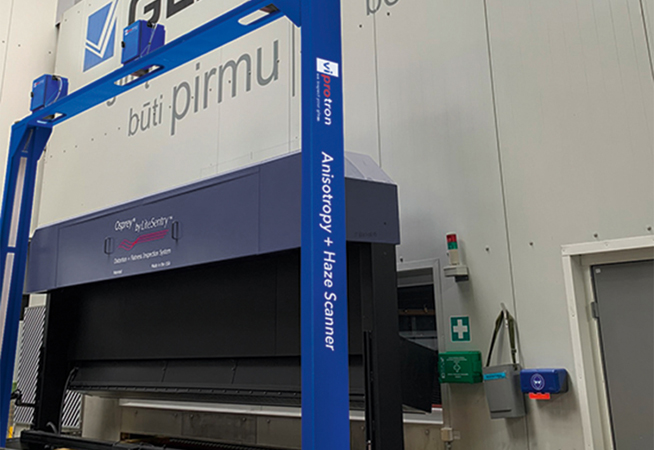Post Time:Oct 26,2020Classify:Company NewsView:1387

Since 2001, GLASSBEL (Lithuania) has been constantly growing and building its reputation as a leading glass processing company focusing on architectural facade and interior glass markets. They decided to add highest quality equipment, workflows and tools to support their main strategy: “Established to be the First in Quality”.
In the last years GLASSBEL invested heavily to underline its leading position as one of the best glass suppliers in Europe. Always with product quality in mind, they ordered three Viprotron Scanners for their existing and new lines.
The first Quality Scanner 3D was installed in the LiSEC IG line with some very helpful features like the Defect Pointer. One horizontal and a few vertical LED-Strips quickly show defects on the glass via lightspot and bring a good push in productivity. A user-friendly display helps to run the scanner easily and efficient, right from the beginning.
A second scanner was placed in line right behind the oven to check anisotropies and haze. Viprotron’s scanner development concept of an Anisotropy and Haze Scanner could stand any competition. The scanner is working very well, and the operators still learn more details about the furnace control regarding different coatings, tints, etc. from the results shown by the scanner.
“We are sure that this is a scanner technology of the future and by the time there will be common standards. Then GLASSBEL will be ready to match the demand with our Anisotropy Scanner!” said Romas Žvirzdinas, Head of Quality. Everything is jumbo
Everything is jumbo
The tempering, the lamination, the IG production – with a maximum size of 7,000×3,210mm for processed glass, GLASSBEL offers an extended jumbo format.
Forel was chosen as supplier for a new seven-meter Jumbo IG line. Although in their standard, Forel has different scanner suppliers, GLASSBEL insisted on Viprotron. The high detection performance of a Quality Scanner 3D and Defect Pointer and the classification algorithms, using all three channels as base for their work, made a clear decision. For example, the scanner easily distinguishes between a glass and a coating scratch or between a bubble and a water drop. Important for root cause or automation.
Having again made good experience with the detection performance of the Quality Scanner 3D, now the customer plans to include the fourth Viprotron scanner into the lamination production line.
“With the help of the scanners, GLASSBEL could already greatly reduce claim expenses and the scanners helped to save a lot of time when handling claims issues internationally. It is a big success and one of the main points appreciated by us.” – Dmitri Sobolevski, owner of GLASSBEL
Source: glassonlineAuthor: shangyi
PrevFeneTech and Midway Windows & Doors
VERCANE: R&D programme to reduce carbon in the glass industryNext